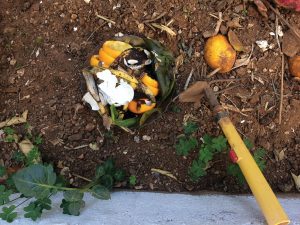By Najla Abdellatif Vallander
Food waste has come to attention internationally, as both the European Union and the United Nations are demanding that European countries reduce their food waste to half by the year 2030, as part of the sustainable development goals. In Palestine, food has always been integral to cultural heritage. Agriculture is not only a fundamental part of the economy, it is also of great significance to Palestinian identity. Sadly enough, this symbolic value of food as a part of cultural heritage gets obscured by the tremendous amount of food that is wasted. Globally, one third of the total food produced is wasted – which theoretically is enough to feed three billion people. In the MENA region, an estimate of 210 kg of food is lost per person per year.*1 These are distressing numbers when put into context, considering the resource and water scarcity in the region. Moreover, food insecurity is increasing, as about 27 percent of the Palestinian population is considered to be food insecure.*2 What is more, not only does food waste end up in landfills, significantly contributing to climate change, it also involves social and economic value losses.
As consumers, we can engage in simple yet effective ways of significantly reducing the waste that results from our households. Food waste happens when we don’t handle our leftovers, when we buy more than we need, or simply when a vegetable does not meet the “beauty” standards of the industry. Shape, color, and size are the main drivers of food selection on consumer levels. You could forget about the “cosmetic standards” placed by grocery stores on fruits and veggies and buy ugly-looking produce as long as it is not spoiled.
Most foods are safe to consume longer than frequently advertised. Unless signs of spoilage such as mold appear, most foods can be consumed past their stated expiration date. The lifetime of your veggies and produce can be extended by, for example, putting carrots, herbs, and leafy greens in glass jars with water. This will keep them fresh longer. If you plan your shopping list carefully, it is possible to avoid buying more than you need. Any resulting leftovers can be stored in food containers.
You can cook with food scraps; in fact, there are many recipes available online that advertise this practice. Perfectly usable parts of vegetables can often be used for cooking nutrient-rich meals. For example, you can make a salad from herb stems and carrot tops, or veggie stir fries with leftover broccoli and beet stems. Last but not least, much food is wasted at restaurants, and bringing your own food container when dining out is a good way to store leftovers and avoid disposable to-go boxes.
Composting is also a great way to make use of your organic waste because the process turns it into nutrient-rich soil that can be used as a natural fertilizer for gardening. All types of food can be composted, except for meat, fish, grease, and dairy products, which tend to attract unwanted pests. You can easily compost in your own backyard by piling up leftovers and digging these directly into the soil. Or throw them into a compost bin together with some paper scraps and occasional watering.
The importance of engaging in waste-reducing practices increases when viewed within the context of land confiscation, lack of control over natural resources, and restrictions on food production that Palestinians face under occupation. In this sense, dealing responsibly with food waste is not merely a matter of reducing one’s ecological footprint but also an indication of an appreciation for the land and for the sense of national identity that is linked to it.
*1 Mohamad G. Abiad and Lokman I. Meho, Food loss and food waste research in the Arab world: a systematic review, American University of Beirut, 2018, available at https://staff.aub.edu.lb/~lmeho/abiad-meho.pdf.
*2 Simona Bencivenni, Food Loss and Waste in Palestine: A pilot study of the FAO methodology, master’s thesis, Politecnico Milano, 2017, available at https://www.politesi.polimi.it/bitstream/10589/136379/1/2017_10_Bencivenni.pdf.



